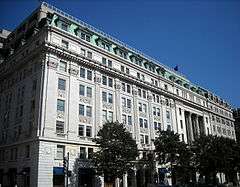B. Stanley Simmons
| B. Stanley Simmons | |
|---|---|
| Born |
1872 Charles County, Maryland |
| Died |
1931 Washington, DC |
| Alma mater | MIT |
| Occupation | Architect |
| Buildings | National Metropolitan Bank, Lafayette Hotel, Fairfax Hotel, Barr Building |
Architect B. Stanley Simmons (1872–1931) was an American architect.
Life
He was born in Charles County, Maryland in 1872, but came to Washington, DC as a child where he later established his career in architecture. Simmons received his architecture degree at the University of Maryland, and later studied architecture at MIT. Over the course of his long career, Simmons worked with every major Washington, DC developer, including Harry Wardman and Lester Barr. He started designing and building houses in the 1890s, before he moved on to bigger commissions.
His career spanned several decades from the 1880s to the 1930s during which time he established himself as an extremely prolific architect, designing more than 280 buildings in the city. Simmons also worked with every major developer, though he appears to have had a particularly close working relationship with Lester A. Barr and later his son, John L. Barr with whom he designed some of his best known commissions. Simmons was incredibly versatile, designing a variety of building types that ranged from row houses, to fraternal clubs, to commercial and institutional buildings, though he seems to have had a proclivity for apartment buildings, having designed over 60 of them. Of particular note on his resume are his designs for the National Metropolitan Bank at 15th and G Streets NW (1905), the Elks Club at 919 H Street NW (1908, demolished); and the Fairfax Hotel at 21st and Massachusetts Avenue NW (1921), in addition to the Wyoming Apartments and the Barr Building.[1] His earlier Hume School, built in 1891, is on the National Register of Historic Places, along with the National Metropolitan Bank Building and the Wyoming Apartments.[2]

Although he never studied at the École des Beaux-Arts, B. Stanley Simmons became a student of the Beaux Arts tradition and the City Beautiful Movement. While his earlier 19th-century buildings (namely speculative row houses) reflect Victorian styles of architecture, his later early 20th-century buildings are grander and more monumental structures that reflect a variety of academic styles inspired the City Beautiful movement. For instance, the now-demolished Elks Club at 919 H Street, NW, the Fairfax Hotel, now known as the Ritz at 2100 Massachusetts Avenue NW, the Northwest Savings Bank, at 1789 Columbia Road, all executed in a Classical Revival style, or the Charlesfred Apartment building at 1705 P Street, N.W., designed in the Renaissance Revival vein, are all indicative of the influences of the Beaux Arts tradition. Though stylistic divergent from these more Classically rooted examples, the Barr Building is similarly characteristic of a studied and academic interpretation of the Medieval Gothic style typical of the student of the Beaux Arts tradition.
References
| Wikimedia Commons has media related to B. Stanley Simmons. |
- ↑ http://www.chrs.org/Pages/2_Issues2_BTB/2_Issues_BTB4.html
- ↑ National Park Service (2009-03-13). "National Register Information System". National Register of Historic Places. National Park Service.